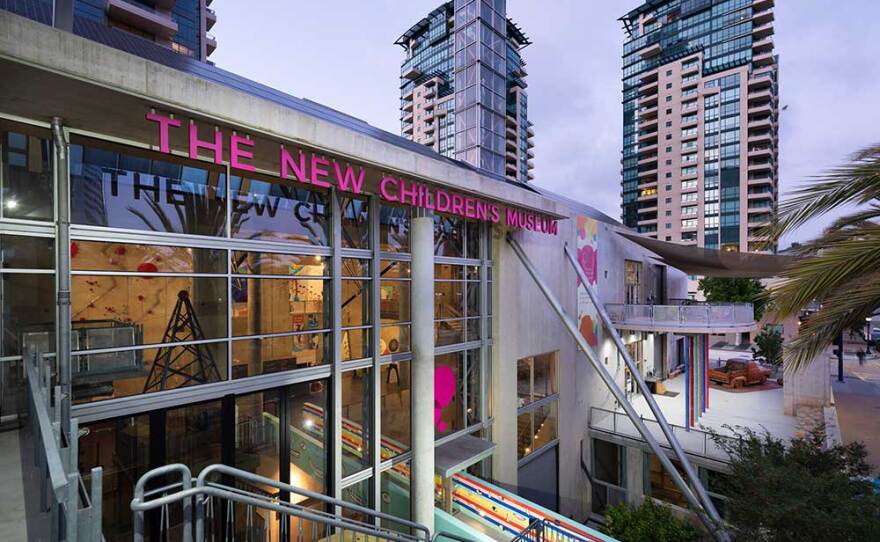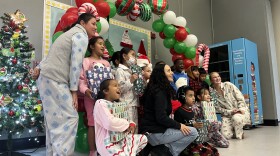In October of 2019, workers representing the organizing efforts of the New Children's Museum filed their intent to unionize. Negotiations with management began in January 2020 and continued nonstop until last month. The museum announced an agreement on the first contract on Monday.
Early-Pandemic Layoffs
For NCM workers and union organizers like Jill Grant, this has been a difficult year. Grant was laid off — like much of the bargaining unit — in May.
A bargaining unit is the group of employees that are eligible to join the union, generally the portion of a workforce not in supervisory roles. In the New Children's Museum's case, the majority of the bargaining unit were visitor-facing staff.
Fifty-two employees were laid off in May, including 34 of the 43 members of the bargaining unit — just days after a negotiation session with management.
"We kept roughly 20 people on staff off and on throughout the year," said Reed Vickerman, interim executive director of the New Children's Museum.
During the closure, the museum moved as much as they could online, but in a hands-on museum with school field trips and immersive installations at the heart of their model, things screeched to a halt for much of the workforce when the museum doors closed. Artists created hands-on DIY art projects, and the museum sent kits and distance-learning programs to schools, but that work was carried out with reduced staff.
"The challenge is the vast majority of the bargaining unit are people who work with guests in person," Vickerman said. "And so those staff were not able to be retained because we were closed. Literally everyone went home on the 16th of March and there were months where no one was in the building."
17 Percent Increase
"It was a really difficult thing to experience and we still kept coming back to the negotiating table because there were still workers on furlough and we still had a contract to negotiate," said Grant of the layoffs. "Our commitment to agreeing on a fair contract didn't change. We just kept going, because we knew we would reach a point where we would come back to the museum. And we're at that point. We're going to go back to the museum with 17 percent average wage increases."
In addition to the 17 percent average wage increase for workers, the contract also includes a new starting wage of $15.75, COVID protections for employees, bargaining unit participation on design committees and the annual board of directors conference, increased holiday pay and time off, overtime for museum load-in and load-out assignments and recall rights for employees who were laid off.

"We're at the intersection of nonprofits, childcare and the art world where workers are predominantly women and women have been historically underpaid. This labor has been not valued by society and our wages reflect that. This is not just this museum, this is nationwide," said Grant.
Two years ago, Grant didn't fully know what it meant to organize. After working for years at the museum in a senior "play worker" role, as well as prior work in other teaching and childcare roles, she knew something had to change.
"Everyone I know who has worked with kids loves it. We do it because we love it. But just because we love our work doesn't mean we can be exploited for it," said Grant.
'History Has A Tendency To Repeat Itself'
"It's a trend that's out there, especially in museums," Vickerman said of organizing. "Our staff is highly engaged in what we do with our guests, and so they take their jobs — as they should, and we would be grateful for it — very seriously."
Steven Greenhouse, long-time writer on labor issues and author of "Beaten Down, Worked Up: The Past, Present, and Future of American Labor," said that recent enthusiasm about organizing is partly due to workers seeing more income inequality.
"Many people 21 to 35 are bogged down with student debt and are frustrated to hear they'll be the first generation in American history to do worse than their parents' generation. We've seen a surge of unionizing by young people in several fields, including museums, adjunct professors, newspapers and digital news websites, graduate students, non-profit organizations," Greenhouse said. "When workers see other folks in their field unionizing and then winning raises and better working conditions, many workers say, hey, maybe we should try unionizing, too."
Nate Fairman, business manager for IBEW Local 465 in San Diego which represents the NCM staff, pointed to the history of the labor movement at times of increased income inequality, such as in the Great Depression.
"What we are seeing now is similar to the explosion of union organizing in the 1930s that led to the biggest expansion of the middle class the world has ever seen. History has a tendency to repeat itself. Workers are taking the lessons from the past and working to organize their workplaces for a living wage and a seat at the table," Fairman said.

A Seat At The Table
Vickerman noted that the agreement is progressive. "There's a lot of elements of that agreement to talk about a more collaborative role between the staff and the leadership that I think is very positive, that I think will inform and improve our practice significantly," he said. "I would say it was a really great opportunity for us to really find out what was on their minds and codify it in a way that we can sustain that enthusiasm and that passion that they have for our mission."
On-the-ground staff and workers interacting directly with the visitors and the exhibitions can have a different perspective than management, and Grant and her fellow bargaining unit wanted a voice in some of the decision-making processes at the museum.
"I think in a lot of organizations there's not bad intentions, but there are blind spots," said Grant. "Through this process of coming together and collaborating and discussing consistently over time, we enhanced each other's understanding of what it means to run this organization and operate it. Because we need each other. Management can't do what it does without workers on the floor, and workers, we can't do what we do without the direction and leadership of management. It allows for the organization to operate more holistically, equitably and more creatively."
Moving Forward
The museum hopes to reopen in approximately a month, in early May, including a greater focus on outdoor spaces and re-imagined ways to engage children creatively while also following public health guidelines. Vickerman said that NCM will soon announce an official reopening date, and with it, a plan to bring back the laid-off and furloughed staff.
"There will not be any opening without them," Vickerman said.
Vickerman said it would be a phased reopening and therefore a phased recall, but that the full staff should be back in place within a few months of reopening.
"I'm just excited to see what this means for the museum, to see it in real life, when we go back to work with a contract," said Grant.
"Ultimately, this is for the kids and the families that come to our museum. That's why we're doing this. To create a more sustainable future for the museum. And both management and the workers who do work on the floor need great working conditions, equitable wages," said Grant. "We have the same goal, and negotiations were the process of figuring out how to get there together."






